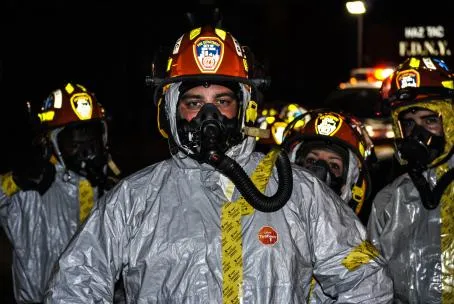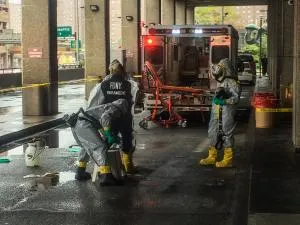Coronavirus: DC 37 Workers on the Frontlines

As the novel coronavirus emerges to threaten a global health crisis, DC 37 is protecting the workers who protect the health of New Yorkers at public hospitals and clinics and in emergencies.
“This is a public health concern, but while there have been seven patients suspected to be infected with Covid-19, or coronavirus, there are no confirmed cases in New York,” said DC 37 Safety and Health Director Deborah A. Williams. “But that can change.”
The union is cooperating with the citywide coordinated plan to monitor coronavirus and has in place practices based on U.S. Centers for Disease Control, NYC Health+Hospitals and the Dept. of Health and Mental Hygiene protocols to protect public employees who deliver vital services.
[caption caption="Local 375 members in protective gear when an Ebola-infected patient was transferred to Bellevue Hospital in Nov. 2014. Photos courtesy of Local 375 and Local 3621." align="left"]
Health agencies are disseminating the most current information to healthcare workers, including DC 37 members 11 locals: SSEU Local 371, Locals 375, 420, 436, 768, 1549, 924, 1189, 1407, and FDNY EMS Locals 2507 and 3621.
Bellevue Hospital houses a premier infection control center. Armed with experience from the handling Ebola, Legionnaire’s, and HIV/AIDS, in a statement CEO William Hicks said, “We are well-prepared to care for patients with special pathogens and keep the hospital safe.”
Bellevue held town hall meetings and conference calls in February attended by labor leaders Local 420 President Carmen Charles, Williams, Local 1189 President Dr. Leonard Davidman, Local 1549 President Eddie Rodriguez, Lillian Goodwine of the union’s Hospitals and Healthcare Professionals Division and others. NYC H+H and the city Health Dept., DOHMH, continue to hold labor-management meetings on the latest science on coronavirus.
“We are being proactive in getting and sharing the facts to ensure the safety of members, who are the city’s first responders to medical emergencies like coronavirus, and their families,” said Charles.
Novel coronavirus, Covid-19, is a new virus and a strain of SARS, Severe Acute Respiratory Syndrome. It causes mild to severe respiratory illness and spreads from person to person. The virus was first identified in Wuhan, China, a city of 11 million people. There is no vaccine or antiviral treatment for coronavirus.
You will learn more facts here.
[caption caption="When a patient was diagnosed with the Ebola virus in Nov. 2014, DC 37 members engaged in preventive safety measures to stop the spread of disease, such as the decontamination of a FDNY Haztac truck. Photos courtesy of Local 375 and Local 3621." align="right"]
Symptoms can range from the common cold to more dangerous SARS. Some patients develop pneumonia in both lungs. Worldwide there are about 60,200 confirmed coronavirus cases and 1,368 deaths — with only 2 outside China. Health agencies said the risk to people outside China is low.
The flu is a more immediate threat and vaccination is recommended. Seniors, people with compromised immune systems, and children are more susceptible to viruses. In the US there are eight confirmed cases of coronavirus and 15 million flu cases with 8,000 deaths this flu season.
The protocol healthcare workers follow includes obtaining a detailed travel history of all patients being evaluated with fever and acute respiratory illness to identify, isolate and inform others promptly. Isolation– a 14-day quarantine — is an important barrier to virus transmission, healthcare professionals agree.
Patients with respiratory illness are asked to wear a mask and are evaluated in a private room with a closed door. Health care personnel wear Personal Protective Equipment, N95 respirators/masks, and goggles or face shields. Specimens are sent to the CDC and results take about 48 hours.
If a patient is identified as having coronavirus, medical professionals immediately notify infection control personnel at their facility and the DOHMH. The patient is isolated, monitored and follows up with the DOHMH.
“We are fortunate that our city has not been impacted, yet,” said Oren Barzilay, president of Uniformed EMTs and Paramedics Local 2507. “The federal authorities are doing a great job at monitoring the situation and testing people who have traveled outside our country upon their return. We’re hopeful the situation will remain under control.”
Williams reminds people to prevent the transfer of pathogens by washing hands frequently and using hand sanitizer liberally. “Refrain from touching eyes, ears, nose and mouth with unwashed hands. Cough and sneeze into your arm, not your hands or the air,” she said. “Stay home when you’re sick.”
EMS crew wearing special protective suits rushed an Ebola patient to Bellevue Hospital in Nov. 2014. Photos courtesy of Local 375 and Local 3621.
Local 375 members in protective gear when an Ebola-infected patient was transferred to Bellevue Hospital in Nov. 2014. Photos courtesy of Local 375 and Local 3621.
When a patient was diagnosed with the Ebola virus in Nov. 2014, DC 37 members engaged in preventive safety measures to stop the spread of disease, such as the decontamination of a FDNY Haztac truck. Photos courtesy of Local 375 and Local 3621.
